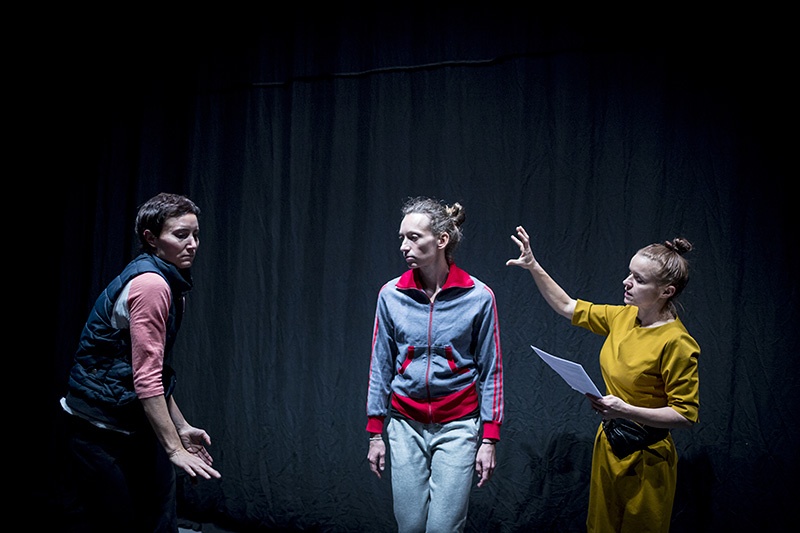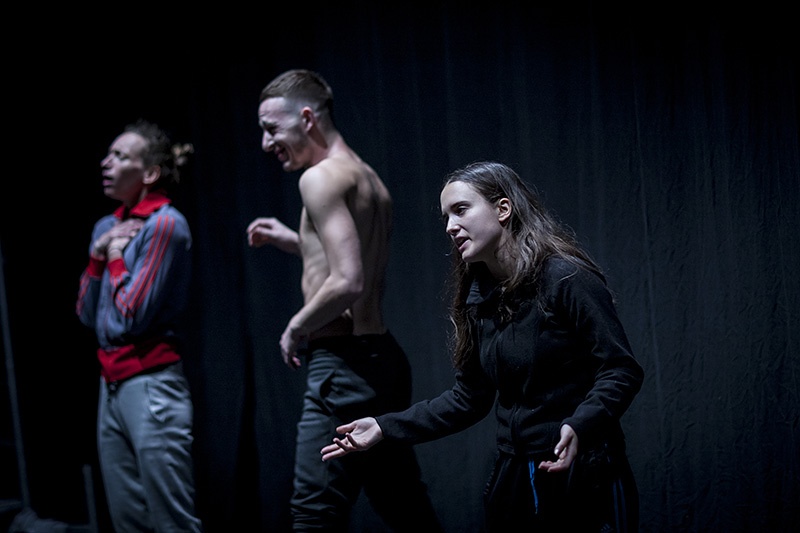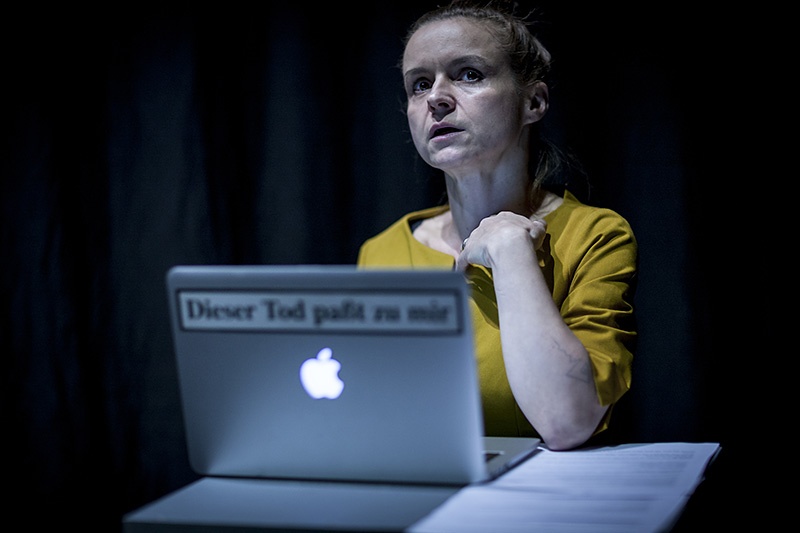 Pojďme na tanec! (Let’s Dance!) is not just an invitation but also a title of a new production of the VerTeDance ensemble. In cooperation with the director Petra Tejnorová and dramaturg Marta Ljubková, the company created a piece based on an annotation Brief Manual for Anxious Audiences. With subtle irony, they describe contemporary dance as an “endangered species”. I don’t share their opinion, though. On the contrary, over the past decade the number of contemporary dance productions and venues where they are presented has considerably increased. Still, it seems that this kind of art remains enclosed in its own world, not much sought-after by the public, maybe because of the fear of not understanding what happens on stage. VerTeDance tries to crack these prejudices using a combination of personal confessions, practical demonstrations of dance passages and lectures into which the audience is also included.
Four performers (Tereza Ondrová, Helena Arenbergerová, Helena Araújo, Martin Talaga) are warming-up, while Halka Třešňáková as a self-confident dance critic explains to the audience the principles and main attributes of contemporary dance, which has its roots back in the early 20th century – bare feet, loose hair, nudity. She muses over the necessity of the presence of bodies and spectators, the importance of the first thirty seconds of a piece, and over the larger number of homosexual artists in the dance world compared to the real world. All this is done in a humorous way you accept from the first moment. Right after her talk, Třešňáková leaves the safe place behind her desk and joins the dancers to disclose some choreographic strategies, to comment on the dancers’ actions or simply step away from their way. Instructions can come from the audience, too, and it is interesting to observe how the dancers digest them. They develop their movement inspirations individually, without much interaction. The scene culminates in a battle of dance and words between Třešňáková and Ondrová. In the fast sequence of actions, it is not obvious who follows who – if Třešňáková interprets what she sees or inspires the dancer’s moves through disparate verbal fragments.
Pojďme na tanec! (Let’s Dance!) is not just an invitation but also a title of a new production of the VerTeDance ensemble. In cooperation with the director Petra Tejnorová and dramaturg Marta Ljubková, the company created a piece based on an annotation Brief Manual for Anxious Audiences. With subtle irony, they describe contemporary dance as an “endangered species”. I don’t share their opinion, though. On the contrary, over the past decade the number of contemporary dance productions and venues where they are presented has considerably increased. Still, it seems that this kind of art remains enclosed in its own world, not much sought-after by the public, maybe because of the fear of not understanding what happens on stage. VerTeDance tries to crack these prejudices using a combination of personal confessions, practical demonstrations of dance passages and lectures into which the audience is also included.
Four performers (Tereza Ondrová, Helena Arenbergerová, Helena Araújo, Martin Talaga) are warming-up, while Halka Třešňáková as a self-confident dance critic explains to the audience the principles and main attributes of contemporary dance, which has its roots back in the early 20th century – bare feet, loose hair, nudity. She muses over the necessity of the presence of bodies and spectators, the importance of the first thirty seconds of a piece, and over the larger number of homosexual artists in the dance world compared to the real world. All this is done in a humorous way you accept from the first moment. Right after her talk, Třešňáková leaves the safe place behind her desk and joins the dancers to disclose some choreographic strategies, to comment on the dancers’ actions or simply step away from their way. Instructions can come from the audience, too, and it is interesting to observe how the dancers digest them. They develop their movement inspirations individually, without much interaction. The scene culminates in a battle of dance and words between Třešňáková and Ondrová. In the fast sequence of actions, it is not obvious who follows who – if Třešňáková interprets what she sees or inspires the dancer’s moves through disparate verbal fragments.
 The lecture on contemporary dance transforms fluently into a personal confession when Tereza Ondrová takes the word and she opens up about the key points of her career. During the evening, each dancer tells his or her story in words and in movement (it is just Halka Třešňáková who is confined to her observation post, where she is sitting, monitoring, typing something on a notebook keyboard and sometimes briefly interacting with the dancers). Although the dancers present their memories in a funny way, these are also very delicate confessions about finding the right dance forms, about discovering and affirming their own identity, their own uniqueness. In short movement sketches they perform various dance styles and talk about personalities who shaped them. Ballet, Martha Graham technique, jazz dance, folk dance but also twerk, samba or vogue. Jan Kodet, Anton Lachky, Akram Khan, Crystal Pite, Jozef Fruček and Linda Kapetanea and many others. A spectator-beginner has an opportunity to watch a brief outline of diverse approaches to dance and movement, and spot the differences. More experienced spectators can just refresh their memories.
The dancers’ life stories alternate with dance passages which help to bridge the changing themes. The most captivating scene was probably the sexually charged duet of Helena Arenbergerová and Martin Talaga with a switch of dominating roles. A self-confident womaniser, in furs and with a cigarette in his mouth, turns into a pigeon-hearted filly under a passionate woman. The theme of sex hangs in the air quite often – be it a mass imitation of copulatory moves in the passage reigned by the Brazilian Helena Araújo, or in the final scene from a strip bar, where Martin Talaga’s feminine seductiveness, fragility and shyness overshadow his female fellow dancers. Considering the duration of the piece (80 min), the weakest passage seems to be the one in which the dancers move in space only by jumping.
The lecture on contemporary dance transforms fluently into a personal confession when Tereza Ondrová takes the word and she opens up about the key points of her career. During the evening, each dancer tells his or her story in words and in movement (it is just Halka Třešňáková who is confined to her observation post, where she is sitting, monitoring, typing something on a notebook keyboard and sometimes briefly interacting with the dancers). Although the dancers present their memories in a funny way, these are also very delicate confessions about finding the right dance forms, about discovering and affirming their own identity, their own uniqueness. In short movement sketches they perform various dance styles and talk about personalities who shaped them. Ballet, Martha Graham technique, jazz dance, folk dance but also twerk, samba or vogue. Jan Kodet, Anton Lachky, Akram Khan, Crystal Pite, Jozef Fruček and Linda Kapetanea and many others. A spectator-beginner has an opportunity to watch a brief outline of diverse approaches to dance and movement, and spot the differences. More experienced spectators can just refresh their memories.
The dancers’ life stories alternate with dance passages which help to bridge the changing themes. The most captivating scene was probably the sexually charged duet of Helena Arenbergerová and Martin Talaga with a switch of dominating roles. A self-confident womaniser, in furs and with a cigarette in his mouth, turns into a pigeon-hearted filly under a passionate woman. The theme of sex hangs in the air quite often – be it a mass imitation of copulatory moves in the passage reigned by the Brazilian Helena Araújo, or in the final scene from a strip bar, where Martin Talaga’s feminine seductiveness, fragility and shyness overshadow his female fellow dancers. Considering the duration of the piece (80 min), the weakest passage seems to be the one in which the dancers move in space only by jumping.
 As could be expected, the audience was not just passively watching and absorbing. Right after the opening talk, the spectators are asked to move from the auditorium to sit on two opposing rows of chairs on stage. But any stronger interaction doesn’t follow - just a graze, embrace, shift, collective singing, or final dance.
The Let’s Dance! project has proved that there is no reason to worry. The aim was also to emphasise the diversity and changeability of this kind of art that depends fully on the performers. This was achieved also through a very diverse group of dancers. Fresh, funny, light, and still conveying a crucial message.
Written from the performance taking place on 11 December 2017, at Ponec Theatre.
Pojďme na tanec! (Let’s Dance!)
As could be expected, the audience was not just passively watching and absorbing. Right after the opening talk, the spectators are asked to move from the auditorium to sit on two opposing rows of chairs on stage. But any stronger interaction doesn’t follow - just a graze, embrace, shift, collective singing, or final dance.
The Let’s Dance! project has proved that there is no reason to worry. The aim was also to emphasise the diversity and changeability of this kind of art that depends fully on the performers. This was achieved also through a very diverse group of dancers. Fresh, funny, light, and still conveying a crucial message.
Written from the performance taking place on 11 December 2017, at Ponec Theatre.
Pojďme na tanec! (Let’s Dance!)Concept, dance: Tereza Ondrová, Helena Arenbergerová, Martin Talaga, Helena Araújo, Halka Třešňáková
Direction: Petra Tejnorová
Dramaturgy: Marta Ljubková
Lighting design: Katarína Ďuricová
Scenography: Adriana Černá
Premieres: 30 October 2017, Ponec Theatre




Josef Bartos
Thank you for your thoughts. One got stuck in my mind – that passion makes us different from AI. Just yesterday I read…I am a dance critic. I am a member of an endangered species